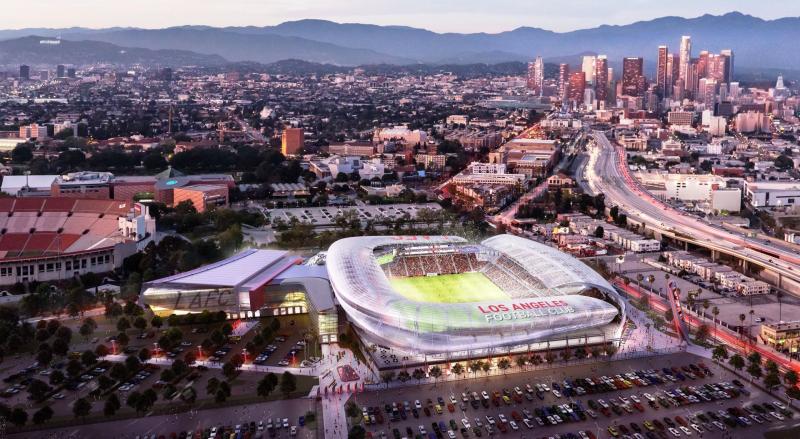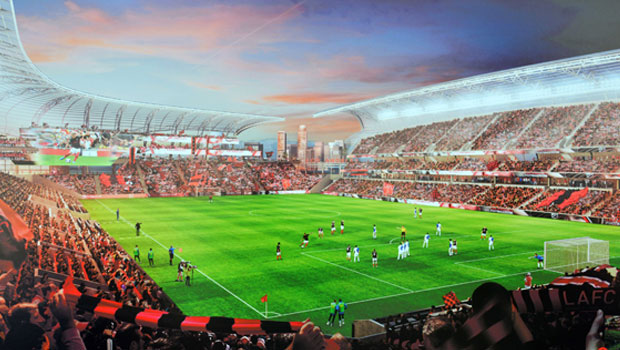Is Los Angeles Ready For A Second Soccer Team? Part 1

Part 1: The Location
For years, the small contingent of rabid soccer fans here have been claiming that the sport is bound to blow up in the United States. In 2015, after multiple exciting World Cup runs and the revamped MLS, soccer may have finally arrived in full force.
Look no further for proof than the land of the defending MLS Champion LA Galaxy, where the soccer market is set to duplicate as a second team will make its Los Angeles arrival in 2018.
LAFC is set to make Los Angeles into one of the few two-team soccer cities in the country, perhaps creating a dynamic much like that of the Clippers and Lakers that attempts to cover every corner of the Southern California market.
This is the introductory installment of a three-part series that will look at how the new Los Angeles Football Club fits in the LA scene through different perspectives in the soccer community, as well the surrounding city community that will house the new team. First, the most recent novelty that demands attention is the all-important announcement of the site where the new stadium will be built.
For a team to thrive in a city where the selection of sports team is larger than most and entertainment can be found around every corner, location is a crucial component. On May 19, the club sought out to take care of that by officially announcing that the current Sports Arena in Exposition Park will be where the new team laces up their cleats in 2018.
“We only have one chance to make a first impression, and we want to do it in our new stadium and new home,” said managing partner Henry Nguyen, at the press conference where the location became official. “We want it to be one of the cathedrals of soccer in this country and around the world.”
The site of the arena, adjacent to the Los Angeles Memorial Coliseum, has been stagnant and mostly unused for the past few years. To say it is a decade behind in both style and technology would be an understatement.
“The big issue is that the Coliseum and Sports Arena have been there for a long time doing mostly nothing,” explained LAPD officer Irwin Rocha. “That’s a big loss for both the city and USC.”
So when the Coliseum Commission — controlled by USC and responsible for managing the Sports Arena as well — looked at the possibility of a brand-new stadium coming their way, they embraced it.
“The options [were] to keep running the Sports Arena as is, which is an uphill challenge,” said Joe Furin, the general manager of both the Coliseum and the Sports Arena. “Or you find a developer like MLS who would turn this place into a soccer stadium. ”
Furin said the Commission would act as the landlords to the team, collecting rent for revenue on a stadium they are essentially paying nothing to build. Neither are tax payers, for that matter.
The stadium itself is expected to cost $150 million, but plans also include restaurants, retail shops, offices and conference space, plus a soccer museum. All amenities amount to the $250 million price tag that will be fully funded by a powerful ownership group boasting Lakers legend Magic Johnson, soccer star Mia Hamm and former MLB player Nomar Garciaparra.
The 22,000-seat “cathedral” at the cornerstone of South LA will be a soccer-specific venue, but it also hopes to attract the shows and entertainment the Sports Arena once did back in its heyday.
“We don’t have a home tenant, so instead of a guaranteed number of events a year, we usually have to hustle and pick up the phone find someone to book the place,” elaborated Furin. “So it’s a daunting task to book this place over and over again … an MLS team can bring 25–30 events to a place so there’s more usage to the park and more exposure.”
From the franchise’s perspective, the Downtown LA site presents a perfect location that would provide maximum exposure into the one of the largest media markets in the country right away. This is something that was undoubtedly behind the ownership’s desire and ultimate decision to call the site at Expo Park their home.

“This makes us real and it gives us roots and really defines what we’re all about,” Penn said. “Including our name, our colors, everything, it had to come from where we were going to be. So to be authentically LA, right here downtown, was very important to us.”
USC and the Coliseum Commission, on the other hand, made it clear that they are only looking for tenants with the potential to succeed and the shelf-life to survive. They believe LAFC fits that bill.
Said Furin: “We wouldn’t want to enter into an agreement with someone who didn’t have the financial means to have longevity or a sound business plan.”
It appears to be a win-win situation for both parties involved: The university gets a much-needed renovation to the site — and a boon of revenue from the lease — while the team takes an important first step into solidifying their brand at the only location they ever truly wanted.
And who can blame them?
Merely blocks away from Downtown LA at the heart of a commercial neighborhood that already houses the top private employer in the district (USC), all signs point to the Sports Arena as a gold mine. And now, in just 10 months, when LAFC breaks ground, there will finally be someone excavating its hopeful riches.
“We are committed to making our home in South Los Angeles and to be part of the phenomenal development happening along the Figueroa corridor that extends to downtown Los Angeles,” said Nguyen.
Location is certainly key, especially when there’s already a dire blueprint of how not to run a second Angeleno soccer club. The poor precedent set by LAFC’s predecessors, Chivas USA, serves to prove how having one’s own venue is necessary for success and survival.
Chivas, now a mere fable of a team that could not even tap successfully into the ever-growing Hispanic market in Los Angeles, presents a telling case study of how a second soccer team failed to conquer the bountiful but demanding LA market.
The Mexican-based franchise had everything from managerial issues to financial problems that led to its demise. All of that combined with the inability to create and draw a consistent fan base to the games, and the failure to establish plans for their own venue, made the death knell inevitable.
MLS’s subsequent move after pulling the plug on Chivas was to announce LAFC as their successor; a completely new franchise aimed at giving the league an improved second try at the allegedly fertile Southern California market. But LAFC wants nothing to do with the now-deceased franchise and the negative stigma that follows it name.
“We really needed a distinct break,” said MLS commissioner Don Garber in regards to Chivas’ flawed experiment. “We needed to accept that what we did in ’05 didn’t work, and the new team shouldn’t be saddled and burdened with that legacy; the league should.”
LAFC can eradicate all the ghosts of Chivas’ past that they want, but if their own franchise falters, the damning comparisons will run amok.
Will the new team avoid the Chivas’ mistakes and succeed in the Sports Arena? We won’t know until 2018, and it may take even longer to fully formulate a report card. For now, however, the location the team has coveted is officially theirs, and their first step toward a successful tenure appears to be underway.
“It’s just a natural next step in the evolution of development and revitalization of the downtown corridor,” Nguyen emphasized about the location. “The Figueroa Corridor is something that’s been talked about, even for decades, and now we have an opportunity to be one of the southern gateways or landmarks of this corridor.”
In regards to this great location, the clear benefits are at the forefront of visibility at the moment. But the possible problems that may arise could not be clearly surfacing yet. Slowly but surely, the arrival of LAFC will undoubtedly bring some of them out to the limelight. Whether the team is prepared to combat them on their way to what they hope is success, is another story.
In Part 2: Outlining the positive and negative effects of a new soccer stadium for the South LA community.
You can reach Sports Editor Paolo Uggetti here, or follow him on Twitter at @PaoloUggetti



